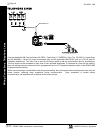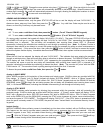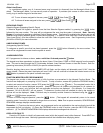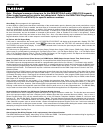
X GEM-P1664 Installation Instructions
L NAPCO Security Systems
WI1424A 1/06
Page 20
BASIC OPERATION
This section provides a brief overview of system operation. For detailed operation, refer to the User's Guide furnished
with the keypad (see page 7 for a listing of User Guides for each keypad) and to the Keypad Programming Modes at
the end of this manual. NOTE: Keypad displays shown in this text are for the GEM-RP1CAe2/GEM-K1CA keypads.
GEM-RP2ASe2/GEM-K2AS displays will be similar, although abbreviated, and will scroll automatically.
USER CODES & ZONE DESCRIPTIONS
(Refer to the GEM-P1664 Programming Instructions (WI1422 and WI1423) for a detailed explanation of programming).
Up to 64 personal user codes may be programmed at the keypad. NOTE: The Area Options associated with each
User Code may only be programmed in the Dealer Program Mode.
Default User Code.
The first code programmed should replace the default (User 01) code, “U01 123 • • • - • • - • • ”, (1,2,3), which should
not be selected as a user code.
Each user should be assigned his own dissimilar code and should be cautioned against divulging his code to anyone
else. Thus should it become necessary to remove a user from the system, that one code may be cancelled without
affecting other codes, and that user would then be prevented from entry. Note: Duplicate User Codes are not allowed
by the panel; therefore a duplicate Code entered in the LCD Window will erase when
U or D is pressed.
Changing or Canceling a User Code
To change any user code, merely program over the existing user code as described in the Programming Instructions.
Similarly, to cancel a user code, blank out each number of the user code.
Arm/Disarm Code (Programmable in Dealer Program Mode only)
An Arm/Disarm Code may be used to arm/disarm the area in which it is programmed. Up to 6 digits may be
programmed or it may be programmed as a two-digit code for the purposes of arming quickly.
Arm-Only Code (Programmable in Dealer Program Mode only)
An Arm-Only Code may only be used to arm the area in which it is programmed; it never has any disarm capability.
Up to 6 digits may be programmed or it may be programmed as a two-digit code for the purposes of arming quickly.
Service Code (Programmable in Dealer Program Mode only)
A Service Code is an Arm/Disarm Code that is easily activated when needed, and dormant at other times. Intended
for the occasional or temporary user (repairman, etc.) who would otherwise be denied access to the premises. It may
then be used to arm and disarm just as any other User Code. A Service Code can be armed/disarmed from a
disarmed state, but it cannot be armed/disarmed from an armed state, after another user code has been entered. Up
to 6 digits may be programmed or it may be programmed as a two-digit code for the purposes of quicker arming.
Access Code
The Access Code will trip the panel's PGM2 Output Relay while armed or disarmed if the “Access Control on PGM2
Output” and “PGM2 Output Access Control Time” is programmed. The Access Code is programmed as any other user
code, but without arm/disarm capability. Note: These systems have not been investigated by UL for compliance with
UL294 (Access Control Systems).
Ambush Code
The Ambush Code is special user code entered by the user typically to cause a silent report to be sent to the central
station. Thus, should the user be forced to disarm by an assailant, he can silently signal an emergency while
appearing to be merely disarming the panel. (Check the glossary for programming required to enable this feature).
Zone Descriptions (GEM-RP1CAe2/GEM-K1CA only)
Zone descriptions follow the Program Code in the normal programming sequence. Program the description, up to two
lines, letter by letter. Enter an identifying description for each zone. Characters are selected by pressing keypad but-
tons multiple times, "Cell Phone" style. Buttons
1 through 9 plus 0 and G are used. Press [A or
R] to move cursor right, press [B] to move cursor left.
To advance to the next zone (or to any other zone), move the cursor to the displayed zone number (i.e., “01”) using
Basic Operation


















